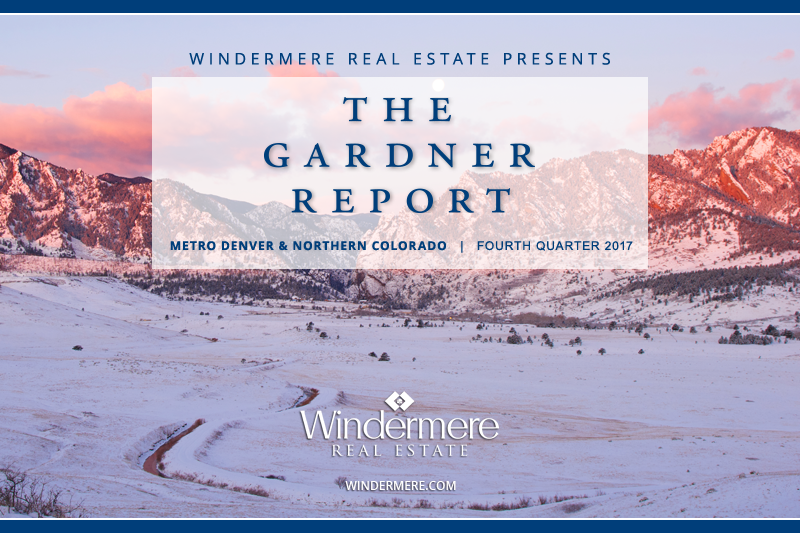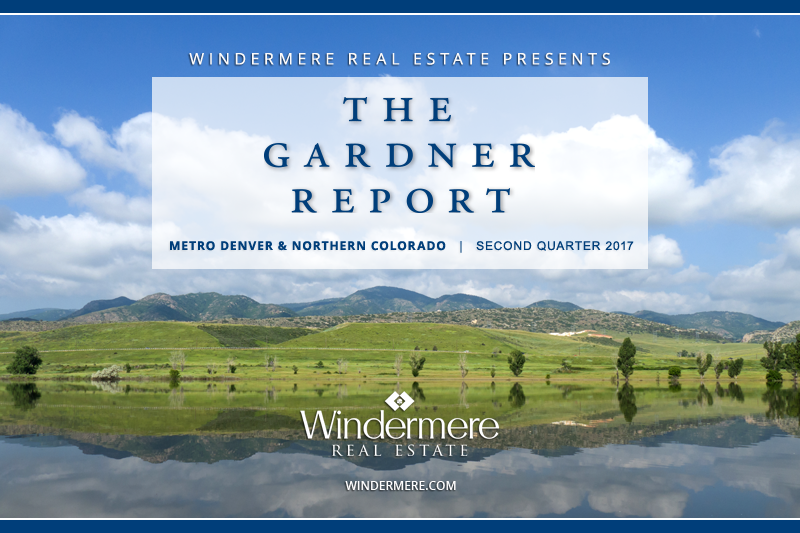You can download the 4-page PDF here: Gardner Report PDF Download
|
|||||||||||||||||||
|
|||||||||||||||||||
|
|||||||||||||||||||
|
|||||||||||||||||||
|

This analysis of the Metro Denver and Northern Colorado real estate markets is provided by Windermere Real Estate Chief Economist Matthew Gardner. We hope that this information may assist you with making better-informed real estate decisions. For further information about the housing market in your area, please don’t hesitate to contact us.

ECONOMIC OVERVIEW
Colorado added 45,300 non-agricultural jobs over the past 12 months, a growth rate of 1.7%. Although that is a respectable number, employment growth has been trending lower in 2017 as the state reaches full employment. Within the metropolitan market areas included in this report, there was annual employment growth in all areas other than Grand Junction, where employment was modestly lower. There was solid growth in Greeley and Fort Collins, where annual job growth was measured at 4% and 2.7%, respectively.
In November, the unemployment rate in the state was a remarkably low 2.9%, down from 3% a year ago. The lowest reported unemployment rates were seen in Fort Collins and Boulder, where only 2.5% of the labor force was actively looking for work. The highest unemployment rate (3.7%) was in Grand Junction.
The state economy has been performing very well, which is why the wage growth over the past year has averaged a very solid 3.3%. I expect the labor market to remain tight and this will lead to wages rising at above-average rates through 2018.
HOME SALES ACTIVITY

HOME PRICES


DAYS ON MARKET

CONCLUSIONS

This speedometer reflects the state of the region’s housing market using housing inventory, price gains, home sales, interest rates, and larger economic factors.
For the fourth quarter of 2017, I have chosen to leave the needle where it was in the previous quarter. Listings remain scarce, but this did not deter buyers who are still active in the market. As much as I want to see more balance between supply and demand, I believe the market will remain supply-constrained as we move toward the spring, which will continue to heavily favor sellers.

Matthew Gardner is the Chief Economist for Windermere Real Estate, specializing in residential market analysis, commercial/industrial market analysis, financial analysis, and land use and regional economics. He is the former Principal of Gardner Economics, and has more than 30 years of professional experience both in the U.S. and U.K.

Let’s get real, there are still a large number of people moving to Colorado.
In fact, 223,000 moved to Colorado from another state last year according to the latest American Community Survey from the U.S. Census Bureau.
The net migration into our state (after subtracting out people who left) was 30,859 people.
In Northern Colorado the net migration looks like this:
So what does that mean for housing? Knowing that, on average, 2.5 people live in each household, the number of new housing units required for these new residents looks like this:

 There are short-term questions about real estate and there are long term questions about real estate.
There are short-term questions about real estate and there are long term questions about real estate.
Clients often have short-term questions like…
How much will prices go up next year? Should I sell my house this Fall or next Spring? Will interest rates go up next week?
We encourage our clients to evaluate those questions in the context of the long-term. There are decades of data on the Northern Colorado market which reveal certain patterns.
When we show our clients these patterns they feel confident and secure in the investment they have made into their home and their rental properties.
For example, the long-term appreciation rates based on up to 41 years of research are as follows:
So over the course of a year prices may go up a lot or go up a little, but in the long term they will stay true to these long term averages.
To see an update as to what is happening in the Northern Colorado market, contact me to receive our quarterly “Scoop” report.

At some point this weekend it’s likely you will make a stop at the local grocery store. When you are there you might  pick up some produce. That produce, as you know, is priced by the pound.
pick up some produce. That produce, as you know, is priced by the pound.
Homes, aren’t priced by the pound of course. But they are priced by the foot.
An interesting way to examine an entire real estate market or a specific home is to look at the price per square foot.
For example, right now our company has a 2,470 square foot home right on the water in Seattle listed at $4,995,000. That comes to $2,022 per square foot.
Meanwhile, we also have a 2,549 square foot home for sale in Timnath priced at $445,000 which is $175 per square foot.
Price per foot is driven by many factors the most important ones being location and finishes.
Here is the average price per foot for our main markets across Northern Colorado:
If you would like to know what your home is worth, per square foot, contact me and I will get that information into your hands right away.


 A question we start to hear from clients this time of year is “am I better off waiting until the Spring to sell my home?”
A question we start to hear from clients this time of year is “am I better off waiting until the Spring to sell my home?”
The perception is that Spring is the busy time for home sales and that a Seller would be better served waiting to sell their home.
The reality is the numbers show that your odds of selling your home in the fall (and even the Winter) are just as good as the Spring. The reason is that the competition from other sellers is much lower in the Fall and Winter.
Let’s see what the numbers say…
We did an analysis of the number of homes that sold last year in each month versus the homes for sale that month and then looked at the ratio. For example, if 500 homes were for sale and 250 of them sold, the ratio would be 50%.
Here are the ratios for certain months in our 3 major Northern Colorado markets:
Fort Collins
Loveland
Greeley
So the numbers tell us that there is no advantage of waiting until the Spring.
Also, all of our clients who are listing their home now see the advantage of dealing with the “known” versus the “unknown” when it comes to interest rates, demand levels and other market factors.
If you would like to see the odds of selling in your particular neighborhood and your particular price range, contact me today.

Check out the FHFA recap video here:
Here is the data straight from FHFA’s report:
U.S. house prices rose 1.6 percent in the second quarter of 2017 according to the Federal Housing Finance Agency (FHFA) House Price Index (HPI). House prices rose 6.6 percent from the second quarter of 2016 to the second quarter of 2017. FHFA’s seasonally adjusted monthly index for June was up 0.1 percent from May.
The HPI is calculated using home sales price information from mortgages sold to, or guaranteed by, Fannie Mae and Freddie Mac. FHFA has produced a video of highlights for this quarter.
Significant Findings
Source: FHFA
The housing market is remarkably tight across the U.S., and you may be wondering if you should wait for home prices to slow before making your move. Windermere’s Chief Economist, Matthew Gardner, shares why waiting could end up costing you more money in the long run.
Should You Wait out the Housing Market?
The housing market is remarkably tight across the U.S., and you may be wondering if you should wait for home prices to slow before making your move. Windermere's Chief Economist, Matthew Gardner, shares why waiting could end up costing you more money in the long run.
Posted by Windermere Real Estate on Friday, August 18, 2017

You can download the 4-page PDF here: Gardner Report PDF Download
|
|||||||||||||||||||
|
|||||||||||||||||||
|
|||||||||||||||||||
|
|||||||||||||||||||
|